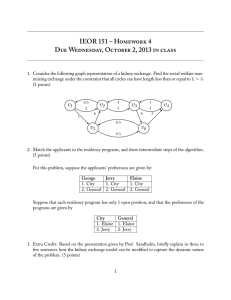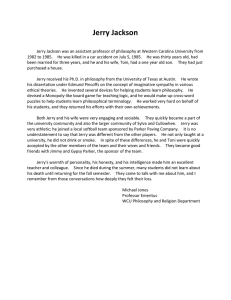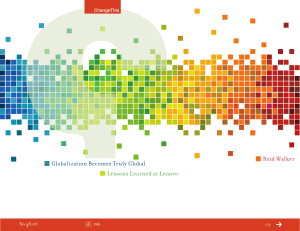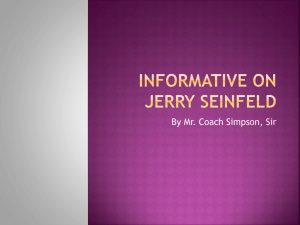Seinfeld on Marketing Bill Gammell 47.06
advertisement
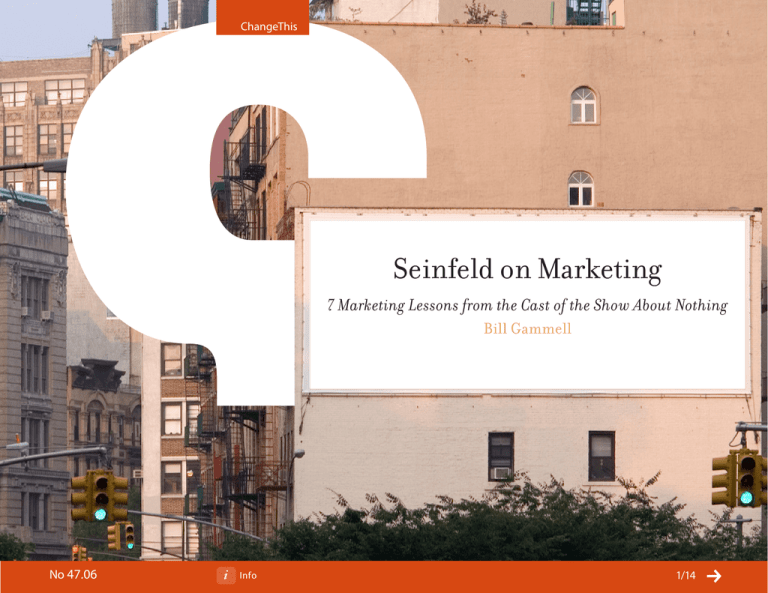
ChangeThis Seinfeld on Marketing 7 Marketing Lessons from the Cast of the Show About Nothing Bill Gammell No 47.06 Info /14 ChangeThis A show about nothing... All this time we thought Seinfeld was a show about “nothing.” Little did we know that peppered in its nine seasons were hidden, real-world marketing lessons taught by the masters themselves. But, unlike the Soup Nazi’s secret soup recipes, these marketing lessons are to be shared freely with everyone. So why did I write this eBook? Anyone who knows me well knows that I watch way too much Seinfeld. So much so that many times during a conversation with someone I’ll remark, “Hey, that reminds me of a Seinfeld episode where Jerry and Kramer are…” Basically, it’s a curse. We’ll that’s all about to change with this eBook. I have decided to use my Seinfeld powers for the good of marketing-kind. Maybe this will help to quiet the voices in my head (doubtful, but one can hope). Even if you have never watched an episode of Seinfeld in your life (shame on you!), you can still participate. I’ll give you the background of each episode so that you can play along at home. …on with the show. No 47.06 Info /14 ChangeThis Marketing Lesson #1: Company Policies and Signs Seinfeld Episode: Jerry bounces a check at a local bodega. He enters the store to talk to Marcelino, the storeowner, about removing his check from the “Do Not Accept Checks From” sign by the cash register: JERRY: Again, I’m really sorry about the check, Marcelino. (Jerry takes out his wallet). Look, let me just give you the forty, plus another twenty for your trouble. MARCELINO: ‘Kay. JERRY (turning to leave): Aren’t you going to take the check down? MARCELINO: Sorry, no. It’s store policy. JERRY: But it’s your bodega. MARCELINO: Even I am not above the policy. The Marketing Lesson: Let’s face it: excessive policies are the “junk food” of business: 1. They seem good at the time. 2. They do more harm than good. 3. They only mask the real problem. 4. They are used out of laziness. No 47.06 Info /14 ChangeThis Just as some people are addicted to Junior Mints, some companies are addicted to policies. A company may first add a new policy because of an outlying situation (a handful of customers are bringing their pets into our store). The company then creates a sign to enforce the policy. The new policy and sign produce other outlying situations (what about working or service dogs?). The company in turn introduces another policy (and sign) to clarify the old policy. Soon the company has conflicting policies that even the employees cannot keep straight. It can turn into a vicious cycle. In the end, the policies and the cycle control the company. Are you controlling your policies, or are they controlling you? In the end, the policies and the cycle control the company. Are you controlling your policies, or are they controlling you? No 47.06 Info /14 ChangeThis Marketing Lesson #2: Brands and Expectations Seinfeld Episode: Jerry is picking up his reserved rental car at the rental agency: JERRY: I made a reservation for a mid-size. AGENT: Okay, let’s see here. (The agent checks on her computer)… I’m sorry, we have no mid-size available at the moment. JERRY: I don’t understand. I made a reservation. Do you have my reservation? AGENT: Yes, we do, unfortunately we ran out of cars. JERRY: But the reservation keeps the car here. That’s why you have the reservation. AGENT: I know why we have reservations. JERRY: I don’t think you do. If you did, I’d have a car. See, you know how to take the reservation, you just don’t know how to *hold* the reservation, and that’s really the most important part of the reservation—the holding. Anybody can just take them. The Marketing Lesson: When you think about it, a reservation is nothing more than an expectation. And quite simply, this is also the definition of a brand. A brand is a perceived expectation in an exchange of value. In other words, if I give you something that I value (my time or my money), then I expect something of value in return from you. The stronger the brand is, the greater the expectation I have. But this expectation of mine goes much deeper than just your products or services. It is an expectation of anything and everything relating to your business. No 47.06 Info /14 ChangeThis For example, my expectation of Apple is “uncluttered and stylish innovation.” Yes, I expect sleek, intuitive new products that are designed with my present and future needs in mind. But I also expect innovative solutions from its employees, understated packaging, a simple setup, an uncluttered Apple Store and maybe most importantly, I expect some of this unclutteredness and style to “rub off” onto me to help me unclutter my life and bring a sense of style to who I am. You see, a brand is not just what I expect from your company; it is also what I expect of myself by choosing your company. If I have an iPod, I expect to be (and probably see myself as) a stylish person. If I buy a safe Volvo car, I expect to be a safe person. If I buy high-class jewelry from Tiffany & Co., I expect to be a high-class person. In other words, I expect to be what I expect of the brand. That is why, in essence, a commodity will never be a brand. There is no expectation of a commodity— other than maybe convenience or price. But these are hardly the building blocks of a strong brand. The thing is, with a commodity, just as soon as something else comes along that is more convenient or better priced, your commodity will be replaced. And it’s sad, really, when this switch happens, because it is not even a conscious decision. Conversely, if I were to switch from Coke to Pepsi (because of repeated unmet expectations), then I would make a mental-note not to purchase a Coke product ever again. However, if my local grocery store switches the kind of celery it sells, I may not even notice (unless I happen to buy a particular brand). What do your customers expect from your brand? No 47.06 Info /14 ChangeThis Marketing Lesson #3: Using Comparisons Seinfeld Episode: George and Kramer are in search of a new wheelchair for a friend. They enter a store that sells wheelchairs: SALESMAN: This is our best model. The Cougar 9000. It’s the Rolls Royce of wheelchairs. This is like… you’re almost glad to be handicapped. The Marketing Lesson: What do you do if someone is unfamiliar with your product or service and you market something that must be experienced (like a massage or skydiving) or is highly technical for the non-user (like SEO or biometric security products)? How might you explain your product or service to someone who is unfamiliar? Besides being crass, the wheelchair salesman teaches us a great marketing lesson. George and Kramer had never up to this point used a wheelchair (later on George uses a motorized wheelchair to keep a job, but this is a topic for a much later discussion). The salesman used a product that George and Kramer were familiar with (a Rolls Royce) and compared it to his product. Using this comparison, George and Kramer did not actually have to experience the wheelchair to understand its benefits compared to other wheelchairs. Do you have a product or service that is not easily explained? Try using a comparison. By the way, if your product is used as the comparison to explain other products, then give yourself a gold star on the forehead! No 47.06 Info /14 ChangeThis Marketing Lesson #4: Exclusivity Seinfeld Episode: Jerry, Elaine and George talk about eating at a new soup place, but there is a catch: JERRY: There’s only one caveat—the guy who runs the place is a little temperamental, especially about the ordering procedure. He’s secretly referred to as the Soup Nazi. ELAINE: What happens if you don’t order right? JERRY: He yells and you don’t get your soup. Just follow the ordering procedure and you will be fine. GEORGE: All right. All right. Let’s… let’s go over that again. JERRY: All right. As you walk in the place move immediately to your right. The main thing is to keep the line moving. It’s very important not to embellish on your order. No extraneous comments. No questions. No compliments. The Marketing Lesson: Providing an exclusive ordering process can elicit feelings of being part of the “in” crowd. Take, for example, the customizable ordering of Starbucks or the “secret” menu of In-n-Out Burger. John Moore of Brand Autopsy, a former marketer at Starbucks, said this of Starbucks’ ordering process: “While it may take a little longer to figure out how to order your double tall, half-caf, vanilla, nonfat latte, once you do, there’s a feeling of belongingness, that you’re part of the “club.” So whether you have an exclusive ordering process, an exclusive membership like Costco or an exclusive community like Harley-Davidson’s HOGS, as long as it is backed by substance, your product or service will scratch the itch of those looking to be an insider. No 47.06 Info /14 ChangeThis Marketing Lesson #5: Naming Your Products Seinfeld Episode: George and Susan are eating dinner with Susan’s cousin, Carrie, and her husband Ken. Carrie and Ken are soon-to-be parents of a baby girl. George decides to “help” the couple choose a name for their baby: SUSAN: So, have you picked out a name yet? CARRIE: Well, we’ve narrowed it down to a few. We like Kimberley. SUSAN: Aww. GEORGE: (negative) Hu-ho, boy. KEN: You don’t like Kimberley? GEORGE: Ech. What else you got? KEN: How about Joan? GEORGE: Aw c’mon, I’m eating here. SUSAN: (warning) George! CARRIE: Pamela? GEORGE: Pamela?! All right, I’ll tell you what. You look like nice people, I’m gonna help you out. You want a beautiful name? Soda. KEN: What? GEORGE: Soda. S-O-D-A. Soda. No 47.06 Info /14 ChangeThis CARRIE: I don’t know, it sounds a little strange. GEORGE: All names sound strange the first time you hear ‘em. What, you’re telling me people loved the name Blanche the first time they heard it? (My sincerest apologizes to anyone named Kimberley, Joan, Pamela, Blanche or even Soda for George’s comments above.) The Marketing Lesson: So you’re in charge of naming your soon-to-be-born product. Congrats! We’ll break out the cigars later, but for now, let’s talk about some naming rules. The name you choose must: • Fit the concept or category. • Be easy to pronounce and spell. • Pass the test of time (no buzzwords or fad-type words). • Resonate with your target market. • Be something that is memorable. • Must not be offensive in any language . Also, you may: No 47.06 • Use made up words (like Google or iPod), but this may require more time for the name to slip into mainstream conversation. • Use common words used out of context (like Apple, Amazon or Soda). However, this again may require more time to allow the association (Amazon and books) to stick. Info 10/14 ChangeThis Marketing Lesson #6: Loyalty Programs Seinfeld Episode: Elaine is trying to earn a free submarine sandwich at Atomic Sub by using her “Buy 23 Subs, Get 1 Free” card: ELAINE: Oh, I can’t believe it! I’ve lost my “Atomic Sub” card! JERRY: So? ELAINE: I’ve eaten 23 bad subs, I just need 1 more! It’s like a long, bad movie, but you want to see the end of it! JERRY: No, you walk out. ELAINE: Alright, then, it’s like a boring book, but you gotta finish it. JERRY: No, you wait for the movie! ELAINE: (Irritated, and through clinched teeth) I want that free sub! The Marketing Lesson: Let’s face it; your loyalty program may not be fostering loyalty. In fact, if done incorrectly, your punch card or exclusive discounts and offers may be actually hurting you. Loyalty can only be earned over time by consistently providing your customers with memorable customer experiences. If your customer experience is faulty (for example, “bad subs”), then the increase in negative word-of-mouth from your loyalty program can actually propel your business into inexistence faster. Remember this formula: Bad customer experience + loyalty program = accelerated extinction Before you start any loyalty program, make sure your customer experience is rock solid (and that loyalty is more than just a “program” in your company). No 47.06 Info 11/14 ChangeThis Marketing Lesson #7: Competition Myopia Seinfeld Episode: A beautiful woman, Danielle, mistakes George for her boyfriend Neil—a guy who she claims looks just like plain, old George. This intrigues George; he wants to meet Neil. George is oblivious to Danielle’s advances and can only focus on finding out how Neil could ever become the boyfriend of this beautiful woman. In this scene, George talks to Jerry about his obsession: GEORGE: I have got to find out how he could get a girl like Danielle. JERRY: (pointing out the obvious) George, you’ve got Danielle. Forget about Neil. You’ve out-Neiled him. GEORGE: (surprised) So, I’m Neil? How did I do that? JERRY: I don’t know, but you better keep it up. The Marketing Lesson: Sadly, George does not keep it up. His obsessive fixation on Neil (instead of focusing on Danielle) led him to lose Danielle to Neil. This reminds me of a marketing professor that I had that would always encourage his students to play the game of Risk. Don’t get me wrong; Risk can be a very fun game. However, I wonder if the tactics learned in playing Risk can actually hurt you as a marketer. The goal of Risk is conquest… worldwide domination. In order to win, you need to learn strategy and make intelligent tactical decisions. These strategic concepts can be very valuable. However, an unhealthy balance of attention and time is given to the enemy because, once you have dominated No 47.06 Info 12/14 ChangeThis your opponent, the country naturally falls into your hands. There is no questioning from the inhabitants as to why you are there. The real marketing world is not like this. Just because you are better than your competition does not necessarily mean that you can take over the marketplace. In the real marketplace, the inhabitants do not take kindly to dictators. The marketplace can only be “won” over if they want to be and if they believe that you provide something of value in return. Knowing the whereabouts of your competition is good business practice. However, focusing on your competition to the point of looking beyond your customers is suicide. Customer centricity will always win over competitor centricity. Customer centricity will always win over competitor centricity. No 47.06 Info 13/14 ChangeThis info About the Author MORE If you have found this eBook helpful or mildly entertaining, you can find more Seinfeld on Marketing lessons and more of my marketing musings at: ubereye.wordpress.com. Feel free to post this eBook on your blog, to e-mail it or share it with whomever you’d like. I’m Bill Gammell…it’s nice to meet you! For the last 6 years I have been working in Orem, Utah in the marketing department of a market research company. I have a BS in Marketing from the University of Utah (although I am a big fan of their rival, B.Y.U.—go figure!). Previously, I worked 4 years as a manager for a technical support department for a local ISP and in customer service positions for over 8 years. I have a gorgeous wife and three adorable kids. send this Pass along a copy of this manifesto to others. Subscribe Sign up for our free e-newsletter to learn about our latest manifestos as soon as they are available. Born on date This document was created on June 4, 2008 and is based on the best information available at that time. Check here for updates. ABOUT CHANGETHIS Copyright info WHAT YOU CAN DO ChangeThis is a vehicle, not a publisher. We make it easy for big ideas to spread. While the authors we work with are responsible for their own work, they don’t necessarily agree with everything available in ChangeThis format. But you knew that already. The copyright of this work belongs to the author, who is solely responsible for the content. You are given the unlimited right to print this manifesto and to distribute it electronically (via email, your website, or any other means). You can print out pages and put them in your favorite coffee shop’s windows or your doctor’s waiting room. You can transcribe the author’s words onto the sidewalk, or you can hand out copies to everyone you meet. You may not alter this manifesto in any way, though, and you may not charge for it. ChangeThis is supported by the love and tender care of 800-CEO-READ. Visit us at 800-CEO-READ or at our daily blog. No 47.06 Info This work is licensed under the Creative Commons Attribution-NonCommercialNoDerivs License. To view a copy of this license, visit Creative Commons or send a letter to Creative Commons, 559 Nathan Abbott Way, Stanford, California 94305, USA. Cover image from iStockphoto® 14/14
